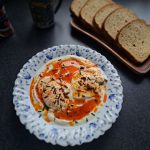Cilbir

Cilbir, a traditional Turkish dish, is a unique combination of poached eggs and yoghurt. The eggs, gently poached, are served over a bed of yoghurt, adorned with a drizzle of warm butter spiced with Aleppo pepper (or similar red pepper flakes).
Since poached eggs play a vital role in Turkish egg breakfast, you´ll have to poach the eggs perfectly to get firm whites encasing a runny yolk on the inside. Poaching an egg is a simple yet delicate cooking technique that requires attention to detail. The spiced butter not only adds warmth to the dish but also provides a beautiful contrast to the yoghurt and the delicate poached eggs. It’s a key component that elevates cilbir from a simple combination of ingredients to a harmonious blend of textures and tastes.
In cilbir, the yoghurt serves as a creamy and cooling base for the dish, balancing the richness of the poached eggs and the spiced butter. Traditionally, strained yoghurt or Greek yoghurt is used in cilbir for its thick and velvety texture. Strained yoghurt is made by draining the whey from regular yoghurt, resulting in a thicker consistency and a higher concentration of protein. This thick yoghurt provides a base for the poached eggs and absorbs the flavours of the spiced butter, creating a delicious contrast of textures and tastes. When preparing cilbir, you can use store-bought strained or Greek yoghurt, or you can strain regular yoghurt at home by placing it in a fine-mesh sieve or cheesecloth to remove the whey.
Peppers
Two popular types of peppers used in cilbir are paprika and red pepper flakes called Pul biber, also called Aleppo chilli. Paprika is a ground spice made from dried red peppers. It comes in various varieties, ranging from mild to hot, and can add both colour and a smoky, sweet flavour to the spiced butter. Aleppo pepper is another common addition to the spiced butter in cilbir. These crushed red pepper flakes impart a subtle heat and a slightly fruity, tangy flavour. It is known for its moderate heat and complex taste, making it a popular choice in Mediterranean and Middle Eastern cuisines.




Cilbir
Ingredients
1 cup = 250ml
- 1 cup room-temperature Greek yoghurt
- 1 garlic clove
- 3 Eggs or as needed
- 25 grams of butter or as needed
- 1 tsp Aleppo pepper Pul biber / smoked paprika
- Pepper and salt
- Dill for garnishing
Ingredients and tools for poaching an egg
- 3 Fresh eggs or as needed
- Water
- 1 tbsp White vinegar optional
- Slotted spoon
Instructions
- Grate a garlic clove into the room-temperature yoghurt and season it with salt.
- Place the Turkish yoghurt/Greek yoghurt on a serving plate or individual plates, spreading it out to create an even layer.
- Poach the eggs (see the instructions below). The key is to have runny yolks. Once poached, carefully place the eggs on top of the yoghurt.
- In a small saucepan, melt the butter over low heat. Add the Aleppo pepper or smoked paprika. Stir gently until the spices are incorporated. Be cautious not to overheat; the butter should be warm, not hot.
- Spoon the spiced butter mixture evenly over the poached eggs and yoghurt. Ensure a generous drizzle to infuse the dish with aromatic flavours.
- Season the dish with salt and black pepper to taste. Optionally, garnish with chopped fresh parsley or dill and an additional sprinkle of red pepper or paprika for added colour and flavour.
- Serve the cilbir immediately to enjoy the warm, runny yolks and the creamy yoghurt at their best.
- Serve with crusty bread, pita, or Turkish bread on the side. You can also include sliced tomatoes, cucumbers, or olives for a refreshing accompaniment.
How to poach an egg?
- Fresh eggs hold their shape better when poaching. Check the expiration date and choose eggs with intact shells.
- Crack the egg into a small strainer and shake it a bit to remove the loose egg whites and then transfer it to a bowl or ramekin. However, this step is optional and not commonly practised in traditional poaching techniques. Then gently slide the egg into a bowl without breaking the yolk.
- Fill a wide saucepan or skillet with about 2-3 inches of water. Add a splash of white vinegar to the water. White vinegar is clear and doesn’t have a colour, unlike other vinegar like balsamic vinegar. This helps to avoid any potential staining of the eggs. The vinegar helps coagulate the egg whites faster, resulting in a neater poached egg.
- Bring the water to a boil and then simmer the heat. Wait for the bubbles to settle down.
- Swirl the water with a spoon and create a vortex on the surface.
- Hold the bowl with the egg close to the surface of the simmering water and gently slide it into the centre of the whirlpool or the pan.
- Cook the egg for about 3 minutes for a completely runny yolk or longer if you prefer a firmer yolk. Keep an eye on the egg to prevent overcooking.
- Carefully lift the poached egg out of the water using a slotted spoon. Allow excess water to drain through the spoon’s slots.
- Season the poached egg with salt and pepper, and serve it on its own, on toast, or as part of your favourite dish.
Notes
- It’s not a common practice to strain eggs before poaching them. Poaching eggs typically involves cracking the eggs directly into simmering water, allowing the whites to coagulate while the yolks remain runny.
- If you’re looking to achieve a neater appearance or remove excess watery egg whites, you can crack the eggs into a fine-mesh sieve or slotted spoon before transferring them to the simmering water. This way, some of the loose egg whites can drain off before poaching.
- Remember that practice improves poaching skills, so don’t be discouraged if your first attempts are not perfect.
- If you’re making yoghurt at home, strain it by placing the yoghurt in a fine-mesh sieve or using cheesecloth. Allowing the whey to drain off results in a thicker yoghurt that enhances the overall richness of cilbir.
- Allowing the yoghurt to come to room temperature before preparing cilbir can enhance the overall taste of the dish. Room-temperature yoghurt tends to have a smoother and creamier texture and blends more seamlessly with other ingredients.
- Be careful not to overheat the butter and spices. Overheating can lead to the loss of delicate flavours and may result in a burnt or bitter taste. The goal is to gently warm the butter, allowing it to melt without reaching a smoking point. This ensures that the spices release their aromatic compounds without becoming scorched.
- If you prefer a spicier kick, adjust the quantity and type of peppers in the spiced butter to suit your taste.
- Cilbir is best enjoyed fresh and warm, so serving it immediately after poaching the eggs is key to preserving its optimal taste.

2 thoughts on “Cilbir”